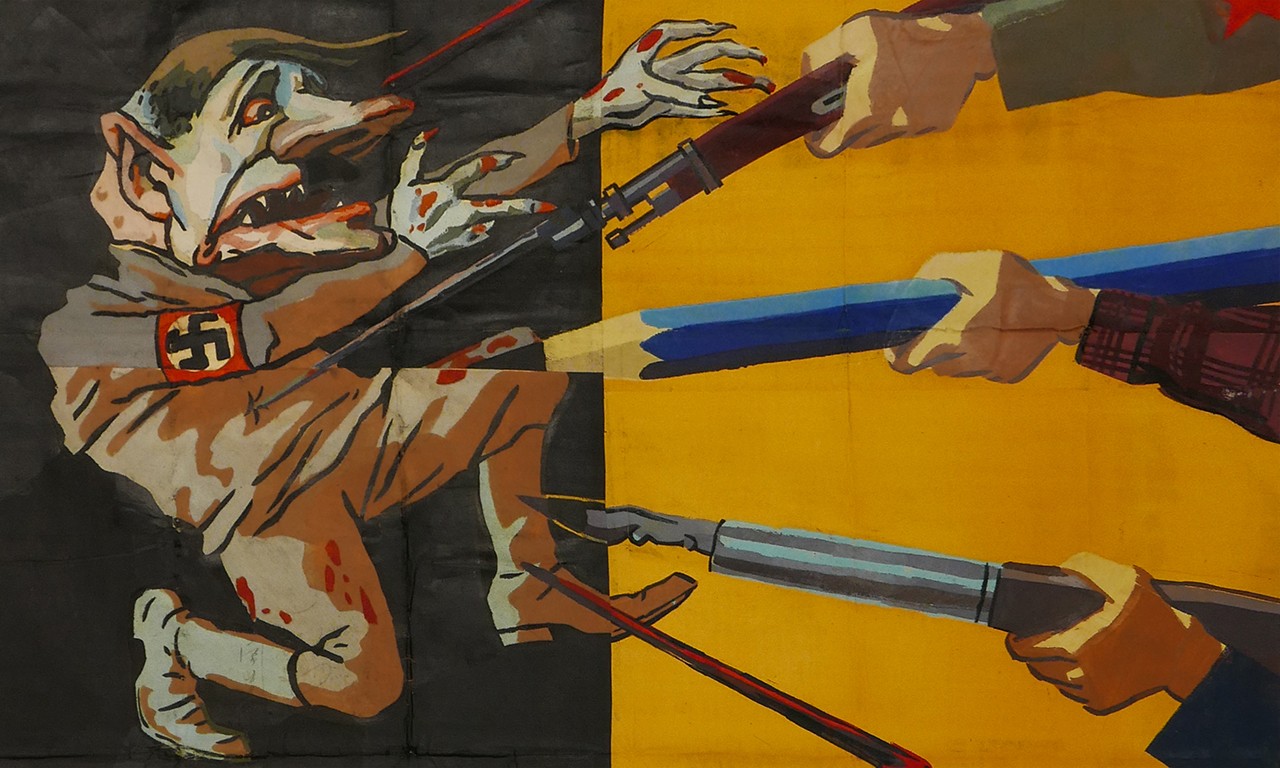 |
Our One Thousandth Blow (TASS Poster 1000), June 5, 1944
Pavel Sokolov-Skalia (Russian, 1899-1961), Nikolai Federovich Denisovskii (Russian, 1901-1981), Vasilli Lebedev-Kumach (Russian, 1891-1949); Moscow, Russia
Ink on Paper
2019.14.6
Bowers Museum Permanent Collection |
Comrade in Arms
When we think of war our first thought is likely of the battlefield, but with the importance of civilian involvement in war efforts and the need for continual recruitment throughout wars, public opinion is every bit as important as the battles themselves. To help garner public support nations often produce pro-war propaganda which during World War II took the form of television and radio broadcasts, films, and—as the subject of today’s blog post—posters. The Bowers Museum recently accessioned a group of six Russian World War II propaganda posters produced by the Telegraph Agency of the Soviet Union (TASS). In this post we look at the history of TASS, how the posters were produced and more on the importance of the satirized images.
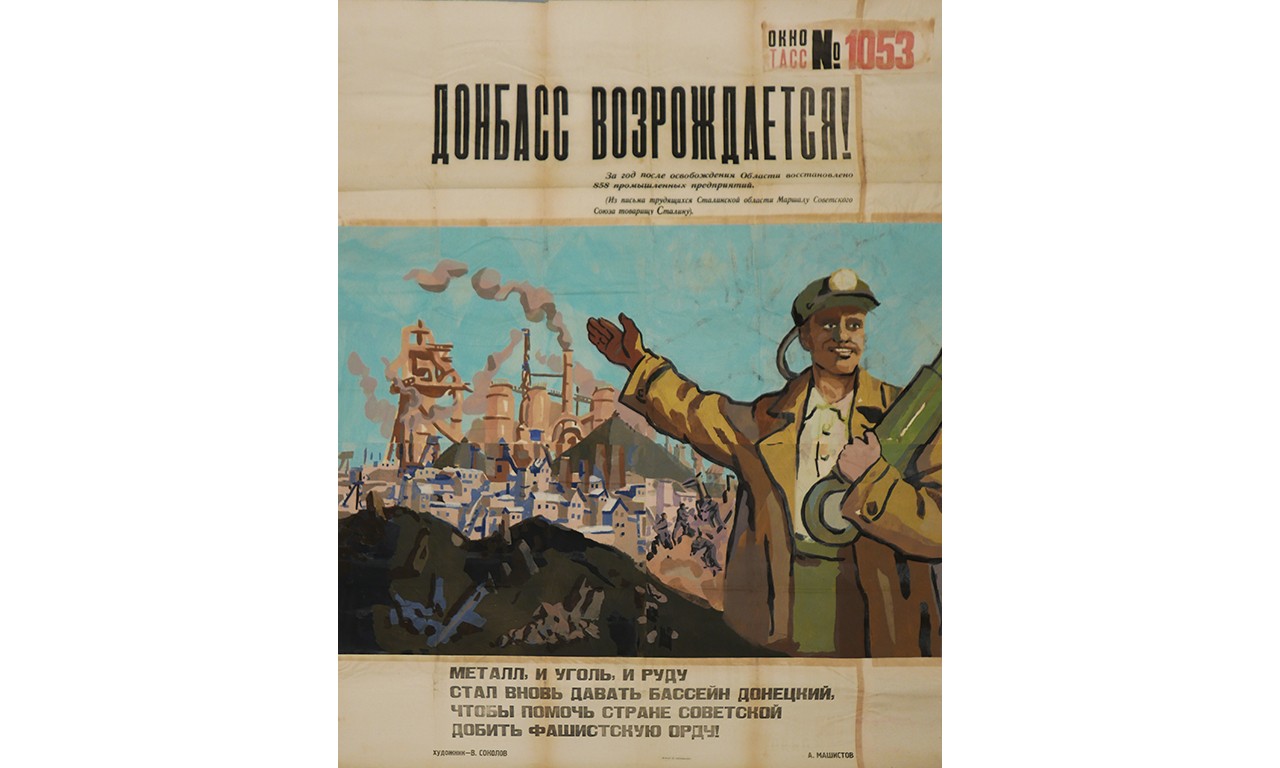 |
Donbass is Reviving! (TASS Poster 1053), 1944
Viktor Pavlovich Sokolov (Russian, 1923-1980) and Aleksei Ivanovich Mashistov (Russian,?); Moscow, Russia
Ink on paper
2019.14.2
Bowers Museum Permanent Collection |
Back in the T-A-S-S
The TASS News Agency was formed in 1902 as a telegraph agency and over time transitioned into the premier Soviet government owned news outlet, one which had the sole authority to gather and control information throughout the Soviet Union. As early as the first World War, part of the function of this agency was the creation and distribution of pro-Russian posters. These covered a variety of subjects, but in wartime they became increasingly propagandistic. Operation Barbarossa, the Axis invasion of the Soviet Union, began on June 22, 1941, and five days later the TASS began to produce anti-Axis posters in support of the new Russian war effort. Over the course of World War II and up until the end of the Nuremberg Trials for Nazi war crimes in 1946, the TASS editorial board and later Iskusstvo were responsible for publishing 1,485 poster designs and between 690,000 and 700,000 posters.
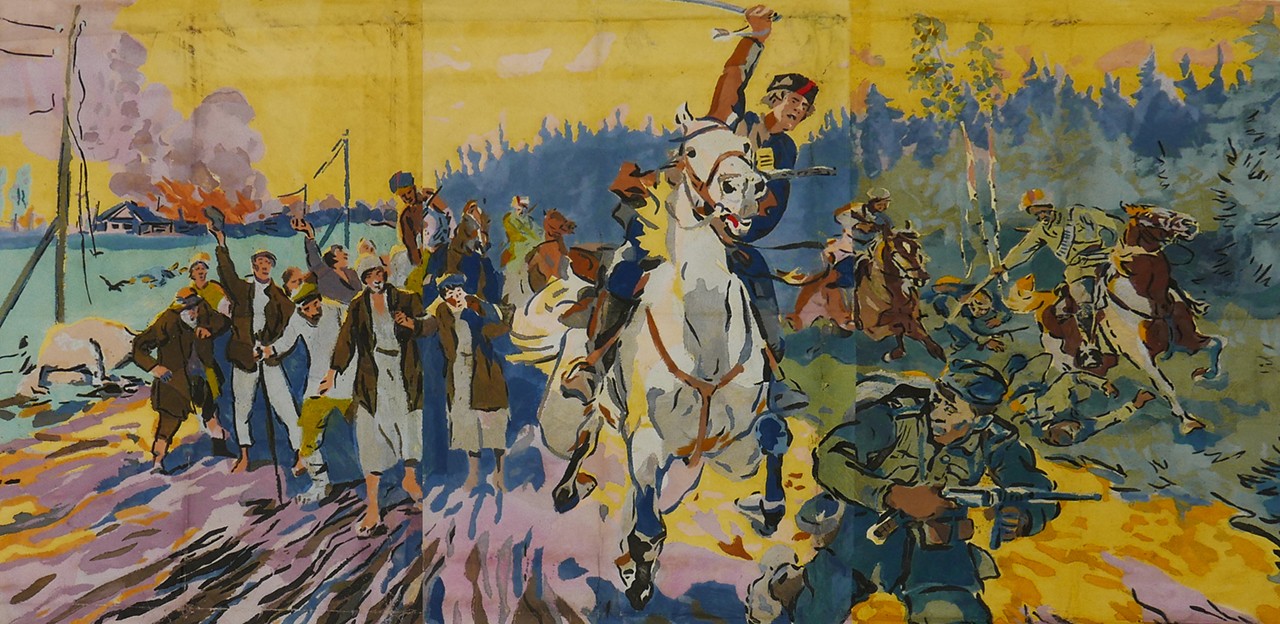 |
Glory to the Belorussian Partisans! (TASS Poster 1021), August 21,1944
Aleksandr Przhetslavskii (Russian, born 1875- deceased) and Aleksei Ivanovich Mashistov (Russian, ?); Moscow, Russia
Ink on paper
2019.14.4
Bowers Museum Permanent Collection |
Poster Process
The posters began as window paintings, but quickly shifted in their mode of production to be produced in more of an assembly line where stencils were used to hand-paint posters on short-fibered pulp paper. The process began like most projects with an original concept. An artist and a poet would then work together to create images and corresponding text that illustrated that message, all of which needed approval by editorial board. Once approved, the posters were assigned their numeric identifier. After this production could begin. The artist next created a full-scale design as a model for stencil-cutters who in turn prepared a complete set of stencils which varied in their faithfulness to the original artist’s model based on a few factors, not the least of which was the total volume of posters which needed to be produced. Stencil painters began working on each edition of poster, creating an assembly line to quicken production. Once the separate parts were painted, including text and number, the components were glued together. After the posters were finished, they were then distributed throughout the Soviet Union via a subscription service and overseas to Russia’s allies.
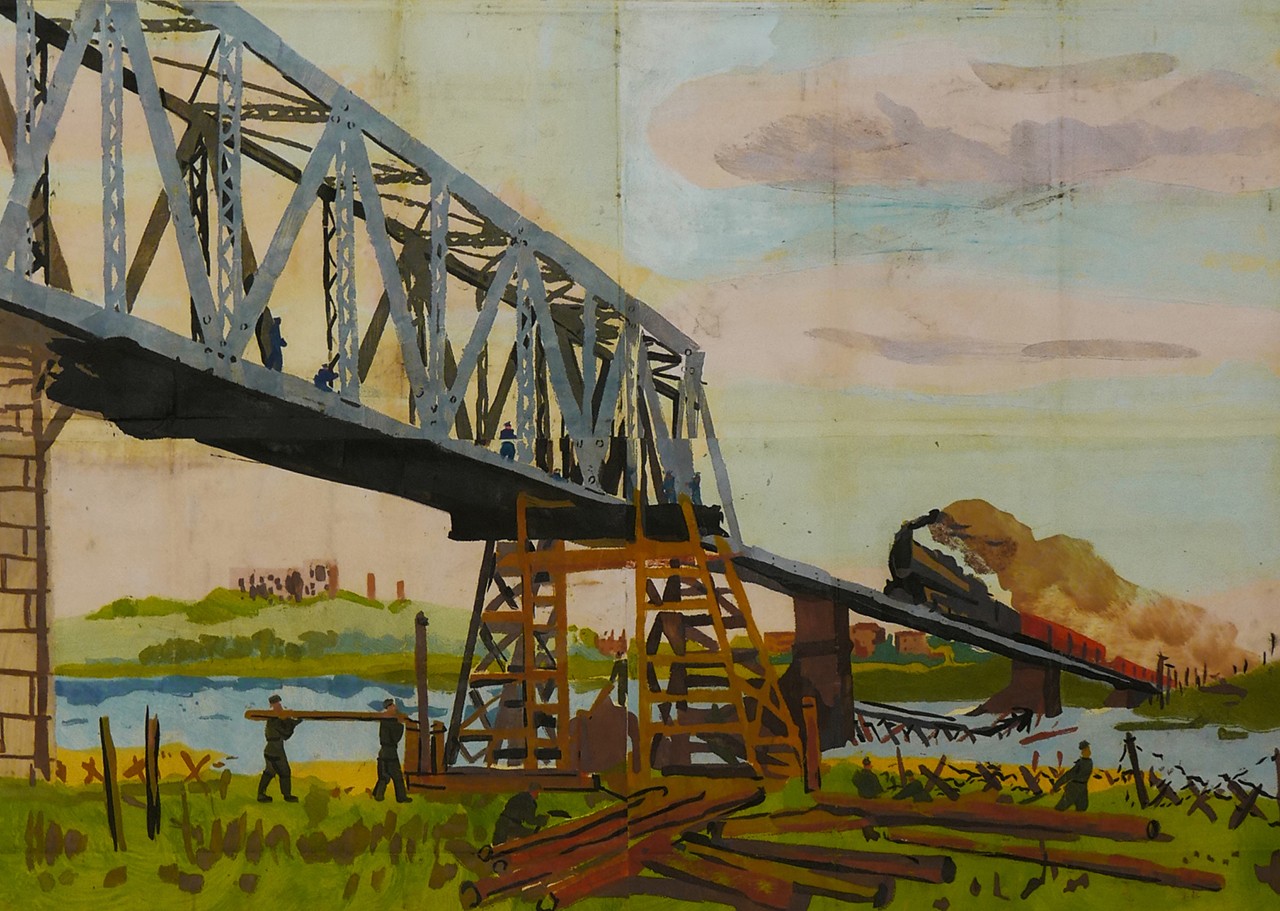 |
Restore What the Enemy Destroyed! (TASS Poster 1036), 1944
Konstantin Aleksandrovich Vialov (Russian, 1900-1976) and Osip Maksimovich Brick (Russian, 1888-1945); Moscow Russia
Ink on Paper
2019.14.3
Bowers Museum Permanent Collection |
VOKS v. Volk
TASS posters were primarily used as propaganda in the Soviet Union but were also sent to Great Britain and the United States as “paper ambassadors.” Rockwell Kent, American artist-activist, was a strong supporter of the Soviet Union’s struggle against Nazi Germany and the first point of contact for the All-Union Society for Cultural Relations with Foreign Countries (VOKS). He coordinated posters being sent to U.S. art museums, including the Art Institute of Chicago and Metropolitan Museum of Art (MET), before the U.S. had even officially entered the war. The MET put on an exhibition titled The Soviet Artists in War in November 1943, which included 25 posters sent by the Soviet Union.
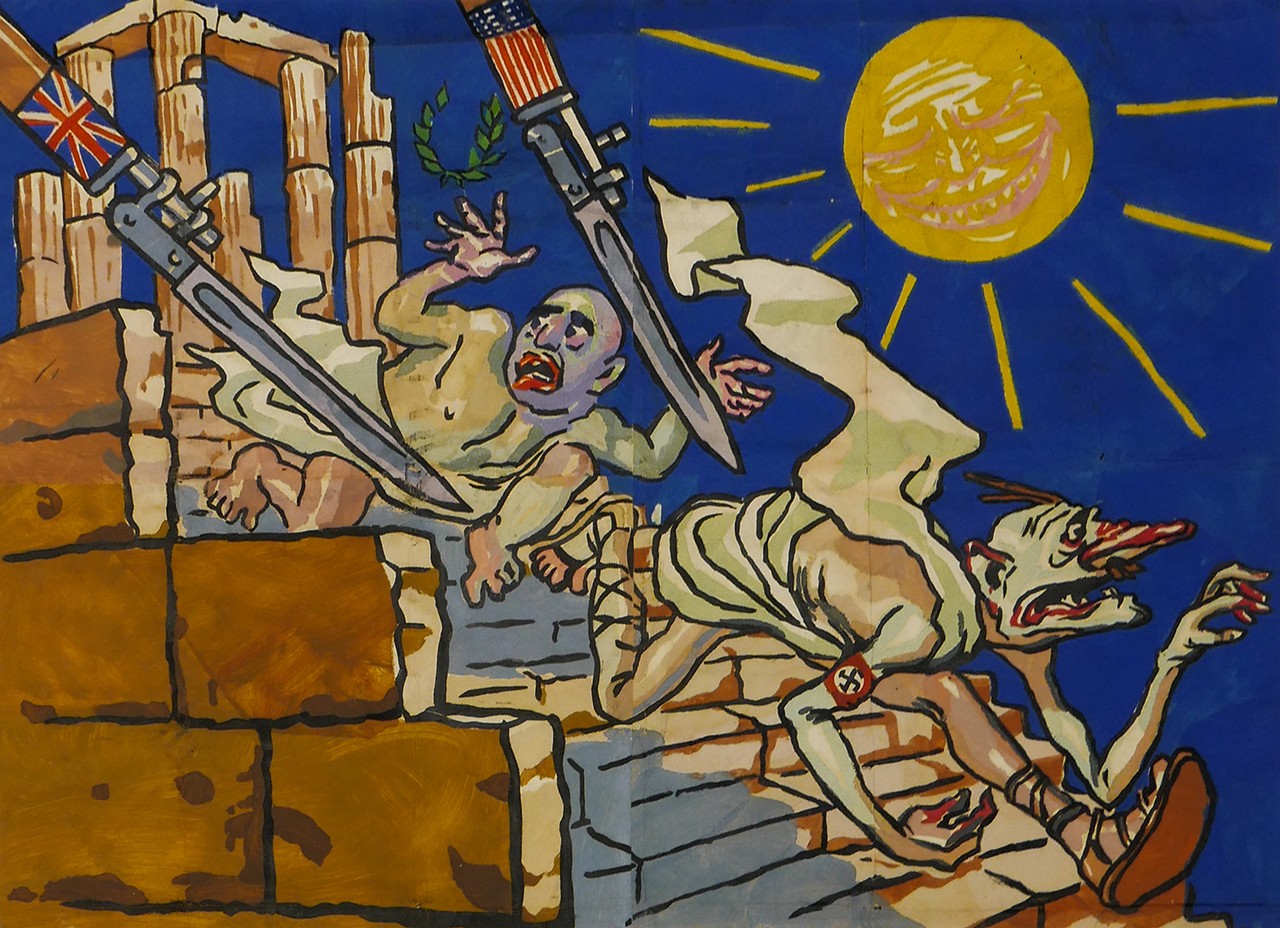 |
The Liberation of Rome (TASS Poster 1001), June 21, 1944
Pavel Sokolov-Skalia (Russian, 1899-1961) and Samuil Iakovlevich Marshak (Russian, 1987-1964); Moscow, Russia
Ink on paper
2019.14.5
Bowers Museum Permanent Collection |
A Goblin Named Hitler
The subject matter of the posters is every bit as interesting as their history and development. The collaboration of poets and artists meant that many times the posters relied on metaphorical imagery, drawing parallels between Russia’s plight in the Second Great War and earlier invasions dating as far back as Napoleon. When they did depict contemporary scenes, the posters often showed brave Russian workers and soldiers, the developing country building or rebuilding from the devastation of the war, and atrocities conducted by Axis troops. Perhaps the most common motif was the dehumanization of Hitler by giving him goblin-like features: sharp, pointed teeth; claw-like, bloodstained hands; elongated nose and ears; gray skin and so on. In one Bowers poster we see Hitler against a black background juxtaposed against a brightly colored Red Army soldiers threatening him with bayonets and writing utensils. This subtle reflection on the role of the artist and author in the war effort illustrates exactly what the Russian government was trying to accomplish by sponsoring the development of these posters.
Research for this post was compiled by Garrett Fritz. Text and images may be under copyright. Please contact Collection Department for permission to use. References are available on request. Information subject to change upon further research.






Comments